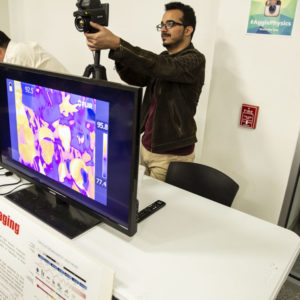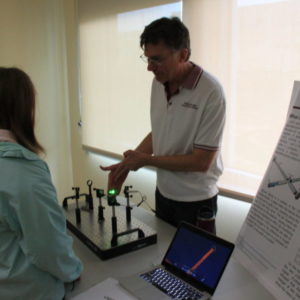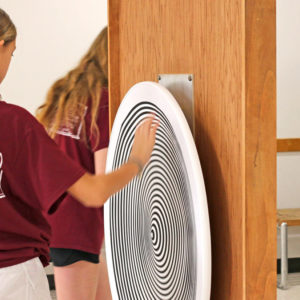Floating head
With a mirror placed below a table and a person positioned such that only their head is visible above the table, the illusion of a floating head is created.
With a mirror placed below a table and a person positioned such that only their head is visible above the table, the illusion of a floating head is created.

Every object with nonzero temperature emits radiation. Our bodies emit radiation in the infrared range. Cameras that are sensitive to these wavelengths of light can make out images of people even when there is no other light in the room since it is our bodies themselves that emit the light even if we can’t see […]
Since the index of refraction of water is higher than air, when the laser travels down the waterfall, it strikes the boundary at a large enough angle so that it experiences total internal reflection and the laser beam is trapped in the stream of water.
In this demonstration, laser light reflects off the surface of a flat mirror as it passes through a non-uniform sugar solution. After each bounce the beam curves in the sugar solution and comes back down to the mirrors surface.
This interactive and competitive game demonstrates the law of refraction, and how it can be used in laser optics. On the game board, there are two sets of laser rigs on top of a magnetic sheet, and the players position their mirrors on the sheet to point the laser into a sensor. The lasers will […]
Semiconductors when set up properly can create light when stimulated with the application of voltage. The problem is that the light that semiconductors can make doesn’t give off the 532 nm light that we see. The addition of a crystal that the infrared light passes through takes the 1064 nm light from the laser and […]
This is a demonstration of the “simplest” lasing medium – the nitrogen in the air. The UV light from the laser is powerful enough to ignite a piece of paper, demonstrating both how lacking our eyes are in terms of viewing the electromagnetic spectrum and the processes involved in making many of our modern devices […]
When light changes from one medium with a given index of refraction to another medium with a different index, the speed of the light changes, resulting in a change in direction for the light. This demonstration shows how changes this difference indices of refraction can alter how we see things, and how lenses work.
This demonstration explores the properties of polarized light and birefringence by allowing one to observe the effects of different polarization conditions.


The infinity mirror is nothing more than a normal mirror, a partial mirror, and LEDs. The LEDs are placed between the mirror and the reflective side of the partial mirror. As the light from the LEDs bounce between the mirrors, some light will pass through the partial mirror each time. This gives the illusion that […]
The gel balls have an index of refraction very close to that of water, about 1.33. That means when light passes from the water through the balls and out again, it does not bend or reflect at all so the balls become invisible in the water.
By mounting a simple laser onto two small finely-tuned motors, it can be programmed to trace out a two-dimensional image onto the wall. Although the full image can clearly be seen, it is merely a single point moving quickly and precisely enough to fool the eye.
Using the law of reflection, participants will angle mirrors to guide a laser beam through a maze to a detector.
How fast can your eyes see movement? With a simple strobe light and a cleverly decorated fan, we are able to see the effects that sudden bursts of light, at the right emission frequencies, can trick our brains into seeing stopped fan when it is actually not. Best of all, it’s an experiment you can […]

A Fresnel Lens magnifies light not by being thicker on the edge or in the middle, but my many ridges on the lens that form concentric circles. This allows the lens to be much smaller than a conventional lens but have just as much magnifying power.
The rainbow colors seen on a soap bubble are due to light’s interference with itself. The specific array of beautiful colors are caused by the thin film that makes up the soap bubble giving this type of interference the name “Thin Film Interference

If you look at an optical illusion, you may think you’re seeing things — such as a curved line that’s actually straight, or a moving object that’s standing still. It is your brain that is playing tricks and trying to interpret the image you see. The demonstration shows the most exciting optical illusions that ever […]
Copyright © 2024. All rights reserved, Texas A&M University Trademark | Texas A&M University, College Station, Texas 77843